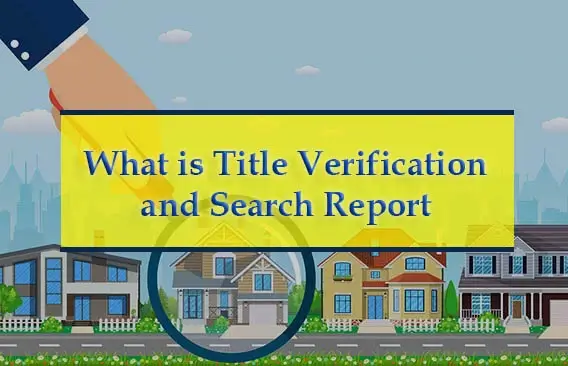Investigation of title is very essential since the ownership of the property is required to be complete, fair & free from any doubts, risks & interest. The purchaser must take all necessary steps at the time of acquiring property to obtain a good & clear title of the land. When search is conducted unto the property of the person who owns it, it is called the Investigation of Title. It is also popularly called as ‘SEARCH‘ into the ownership of the property.
The objective of investigations of title is to ascertain the ownership and title of a given property, in most cases immovable in nature. The attributes of ownership are: –
- Right to have and to get possession
- Right to prevent interference by others
- Power of alienation
- Liberty of using the object according to owner’s will
- Liberty of enjoying the fruits and to avail of the object owned
- Liberty of changing its form and even destroying it

In Maharashtra to check the title verification of the property the investigator must do the following checks: –
- Recent 7/12 Extract (7-12 Utara): – It will give idea about the type of ownership, total number owners (and their share in property) of the property. Loan on the property, tenant in the property (if any), cultivable and non-cultivable area in the property, source of irrigation (if any), assessment for the property, Class of the property, Reservation on property (if any).
- All mutations on 7/12 extract (Ferfar): – Mutations are the entries made by the revenue department in respect of any change in ownership of the property, such changes may be because of death of any owner, Loan obtained by any owner etc. some time it may happen that name of any person appears in Mutation but not in 7/12 extract, to check such things it is advisable to check all mutations.
- Maps: – it is advisable to check maps provided by the government authorities, this gives better idea about the exact location of the property and access to the property.
- Ceiling Limit: – As per the type of the property there is a Limit provided for the holding of the Land, the purchase must check that the Land which he is going to purchase will not cross his limit as well as he has to check that the vendor is also not holding it as excess land. The Khate Utara (8 A Extract) is a document which gives us idea about the exact holding of the owner.
- 6c Certificate (Varas Register): – 6c Certificate is a document which gives us idea about the names of all Legal Heirs of deceased person. This document is very important as, it is noticed that sometimes names of Female Legal Heirs are not appearing on revenue documents, to avoid such ambiguities it is advisable to check 6c Certificate.
- Lis Pendens if any, recorded U/S.52 of the T.P. Act should also be verified with the District Sub- Registrar. It would also be necessary to take search in the office of the collector of the relevant records and it would give the buyer’s advocate the title to the property and show how title has devolved. No doubt should be left unanswered and nothing should be taken for granted where a continuity link is broken and without satisfactory explanation forthcoming therefore.
- Some transactions are un-registered and to check such transaction it is advisable to Publish notice in at least two Local Newspaper and ask for objections. This helps the purchaser advocate to satisfy himself about the title of the property. Claims are invited in the nature of mortgage, lien, charge, lease, easement, gift, trust, or any other claim against the property which is required to be notified to the buyer’s advocate within a period of 15days after which it shall be deemed to have been waived. Such Public Notice supports the buyer’s contention in the case of dispute that he is a bonafide purchaser for value without notice of any claim.
- An Enquiry in Municipal Corporation is necessary (if applicable). It must be inquired whether there are any claims to the property concerned, find out whether there are any arrears of municipal bills or water charges or riot bills in respect of the property agreed to be purchased by the buyer.
- An Enquiry with the Ward Officer in which the property is situated to find out
- Whether the property or any portion thereof has been notified under the Land Acquisition Act for public purpose
- Whether any notice, notification, action or claim is pending against the property.
- Whether any portion of the property is included in the setback
- Whether there is any notice pending against the said property
- An enquiry is also to be made in CRZ and other zones as it is not allowed to any development in such zones it is necessary for the purchaser to check such zones before signing any deed. The purchaser also satisfy himself that the seller is not going to become a Land-less person after said purchase of land.
- The title deeds have to be gone through after arranging them in chronological order and then prepare an abstract of title. The abstract must contain in a nut shell relevant information relating to the deed which is abstracted. An abstract of title contains a gist of the documents commencing with root of title and facts which constitute the vendor’s title.
- For closure in a sale after all these reports purchaser’s requisitions on the vendor’s title to the property is to be prepared. The requisitions are of two type’s general and special requisitions. Special requisitions are objections raised by the buyer on scrutiny and appraisal of the documents produced by the vendor, and relate to title or defects in conveyance. General requisitions are more or less of a routine type of inquiries. A set of general requisitions are those which one may adopt to suit a particular transaction.
- Income tax clearance certificate must be obtained under section 230A of the income tax act. All necessary registration and stamp duty must also be complied with.
Conveyance Deed
Once title verification is done, then arises the stage of preparing draft of the conveyance. The following points are generally covered in the deed.
- Indemnity/ Guarantee from the present owner about his title over property
- Indemnity/ Guarantee from the present owner about his possession over property
- Indemnity/ Guarantee from the present owner about non-reservation of the property
- Point making clear that the said property does not relates with any public activity
- Point making clear that the said property is not a Trust Property
- Point making clear that said property is not a Government Granted Land
- Point making clear that no-one has any right (road/ parking) over said property
- Point about the existing structure on property (if any). Because it may affect valuation of the property
- If the said property is ancestral one, then it is necessary to make all members of the family as consenting parties for the deed.
- Purchase price of the property is agreed mutually, with the schedule of payment
- The Photo Identity Cards of the present owners must be attached to title deed
- Indemnity/ Guarantee from the present owner about Non Litigant property because any transaction for a property for which litigation is pending is null and void in the eye of law
- Boundaries of the property gives clear idea about the exact location of the property. Therefore, it is necessary to mention it clearly in the Title-Deed, a part from this it is advisable to attach a map showing exact location of the property
- Witness to the deed plays very important role if the deal goes in to any Litigation, It is advisable to take one owner of adjoining property as witness as it will help to prove possession of the present owner.
Thus investigation of title is a very vast procedure and it plays prime role in matters of property.




